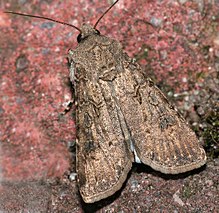Turnip moth: Difference between revisions
Ruigeroeland (talk | contribs) No edit summary |
No edit summary |
||
| Line 18: | Line 18: | ||
This is a very variable species with the forewings ranging from pale buff through to almost black. The paler forms have three dark-bordered [[glossary of Lepidopteran terms|stigma]]ta on each forewing. The main feature distinguishing it from other ''Agrotis'' species is the very pale hindwings, pure white in the males, pearly grey in the females. The [[wingspan]] is 32-42 mm. Two broods are produced each year, the adults flying in May and June and again in August and September <ref>''The flight season refers to the [[British Isles]]. This may vary in other parts of the range.''</ref>. The species flies at night and is attracted to light and nectar-rich [[flower]]s. The species overwinters as a caterpillar. |
This is a very variable species with the forewings ranging from pale buff through to almost black. The paler forms have three dark-bordered [[glossary of Lepidopteran terms|stigma]]ta on each forewing. The main feature distinguishing it from other ''Agrotis'' species is the very pale hindwings, pure white in the males, pearly grey in the females. The [[wingspan]] is 32-42 mm. Two broods are produced each year, the adults flying in May and June and again in August and September <ref>''The flight season refers to the [[British Isles]]. This may vary in other parts of the range.''</ref>. The species flies at night and is attracted to light and nectar-rich [[flower]]s. The species overwinters as a caterpillar. |
||
The grey [[larva]], sometimes tinged with purple, feeds on the roots and lower stems of a huge range of plants (see list below) and can be a serious pest of [[root vegetable]]s and [[cereal]]s. The insect is not believed to be present in the United States, where the government has been making efforts to prevent its introduction on imported food crops<ref>[http://www.aphis.usda.gov/newsroom/content/2006/05/kopepper.shtml USDA - APHIS :: APHIS Newsroom<!-- Bot generated title -->]</ref>. A virus is being tested as a biocontrol on crops in Europe<ref>[http://www.springerlink.com/content/p3688uw760416372/ SpringerLink - Journal Article<!-- Bot generated title -->]</ref>. |
The grey [[larva]], called [[cutworms]]<ref>[http://www.tio.co.uk/documents/TIOGrowerTechnicalNews2.pdf Cutworm name]</ref> sometimes tinged with purple, feeds on the roots and lower stems of a huge range of plants (see list below) and can be a serious pest of [[root vegetable]]s and [[cereal]]s. The insect is not believed to be present in the United States, where the government has been making efforts to prevent its introduction on imported food crops<ref>[http://www.aphis.usda.gov/newsroom/content/2006/05/kopepper.shtml USDA - APHIS :: APHIS Newsroom<!-- Bot generated title -->]</ref>. A virus is being tested as a biocontrol on crops in Europe<ref>[http://www.springerlink.com/content/p3688uw760416372/ SpringerLink - Journal Article<!-- Bot generated title -->]</ref>. |
||
== Recorded host plants == |
== Recorded host plants == |
||
Revision as of 09:52, 20 December 2009
| Turnip Moth | |
|---|---|

| |
| Adult moth | |
| Scientific classification | |
| Kingdom: | |
| Phylum: | |
| Class: | |
| Order: | |
| Family: | |
| Genus: | |
| Species: | A. segetum
|
| Binomial name | |
| Agrotis segetum | |
The Turnip Moth (Agrotis segetum) is a moth of the family Noctuidae. It is a common European species, but it is also found in Asia and Africa.

This is a very variable species with the forewings ranging from pale buff through to almost black. The paler forms have three dark-bordered stigmata on each forewing. The main feature distinguishing it from other Agrotis species is the very pale hindwings, pure white in the males, pearly grey in the females. The wingspan is 32-42 mm. Two broods are produced each year, the adults flying in May and June and again in August and September [1]. The species flies at night and is attracted to light and nectar-rich flowers. The species overwinters as a caterpillar.
The grey larva, called cutworms[2] sometimes tinged with purple, feeds on the roots and lower stems of a huge range of plants (see list below) and can be a serious pest of root vegetables and cereals. The insect is not believed to be present in the United States, where the government has been making efforts to prevent its introduction on imported food crops[3]. A virus is being tested as a biocontrol on crops in Europe[4].
Recorded host plants
The following is a partial list of genera and other taxa which are hosts for the Turnip Moth:
- Acacia
- Allium
- Apium - Celery
- Arachis - Peanut
- Asparagus
- Beta - Beet
- Brassica
- Camellia
- Casuarina
- Cedrus - Deodar Cedar
- Chrysanthemum
- Cichorium - Chicory
- Coffea - Coffee
- Cucurbita
- Eucalyptus
- Fragaria - Strawberry
- Glycine - Soybean
- Gossypium - Cotton plant
- Hagenia
- Helianthus - Sunflower
- Hibiscus - Bissap
- Indigofera
- Lactuca
- Lycopersicon - Tomato
- Malus - Apple
- Medicago - Alfalfa
- Nicotiana - Tobacco
- Picea - Sitka Spruce
- Pinus - Pine
- Pisum - Pea
- Pseudotsuga - Douglas-fir[5]
- Rheum - Rhubarb
- Rumex
- Saccharum - Sugar cane
- Secale - Rye
- Sesamum - Sesame
- Solanum - Potato
- Sorghum
- Spinacia - Spinach
- Tectona - Teak
- Trifolium - Clover
- Triticum - Wheat
- Vigna - urad bean
- Vitis - Grape
- Zea - Maize
References
- ^ The flight season refers to the British Isles. This may vary in other parts of the range.
- ^ Cutworm name
- ^ USDA - APHIS :: APHIS Newsroom
- ^ SpringerLink - Journal Article
- ^ C. Michael Hogan (2008) Douglas-fir: Pseudotsuga menziesii, globalTwitcher.com, ed. Nicklas Strõmberg
- Chinery, Michael Collins Guide to the Insects of Britain and Western Europe 1986 (Reprinted 1991)
- Skinner, Bernard Colour Identification Guide to the Moths of the British Isles 1984
